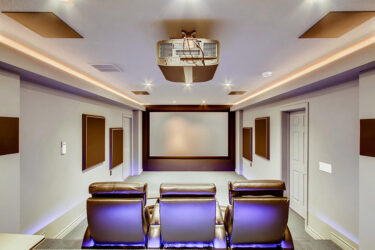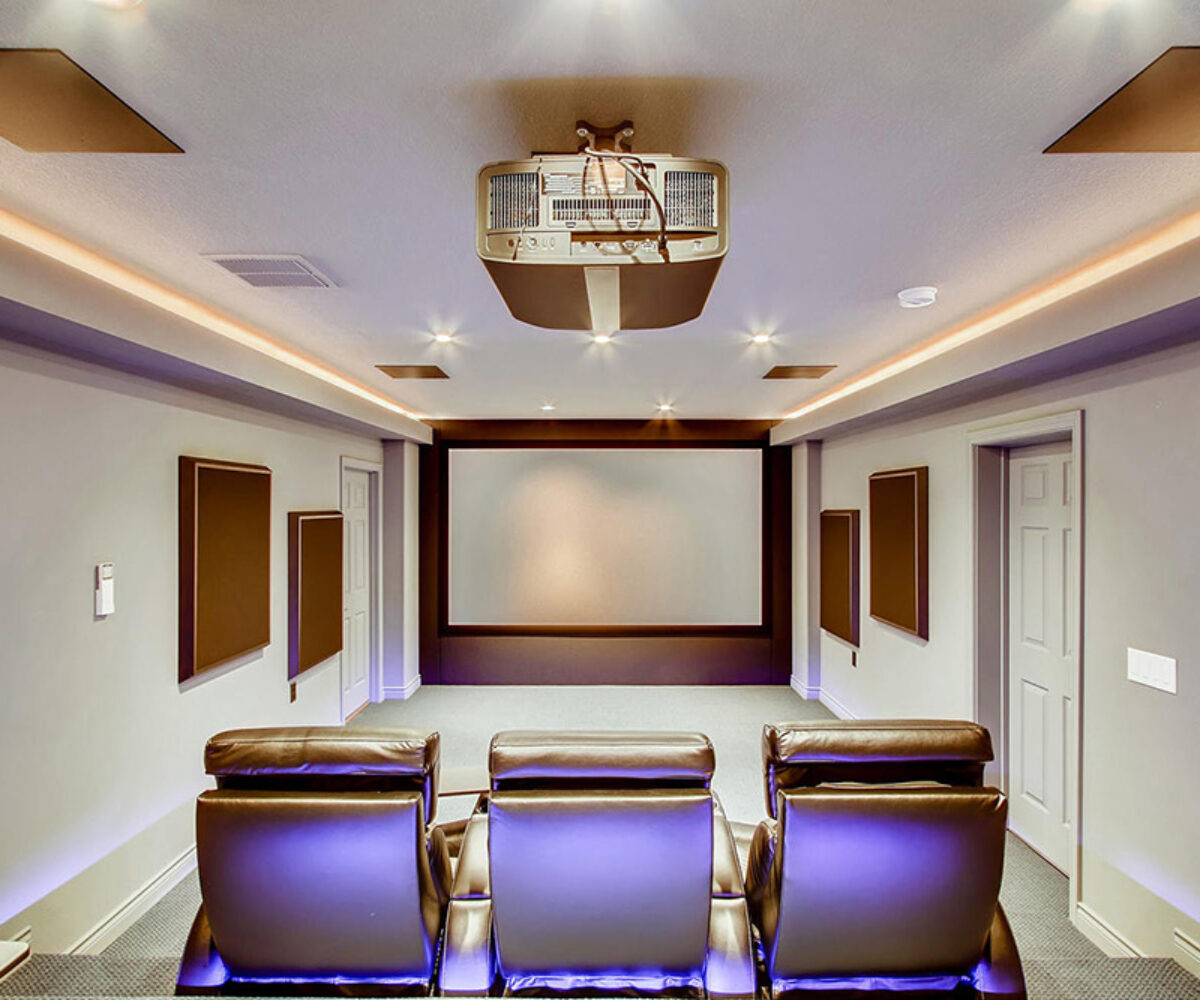10 Factors to Consider When Setting-up a Basement Home Theater
 As COVID keeps more of us at home watching the latest releases from our couches, thoughts of basement home theater finishes become more and more appealing. The combination of coziness, low lighting, and seclusion from the rest of the house makes the basement ideal for a true theater experience.
As COVID keeps more of us at home watching the latest releases from our couches, thoughts of basement home theater finishes become more and more appealing. The combination of coziness, low lighting, and seclusion from the rest of the house makes the basement ideal for a true theater experience.
If this idea sounds enticing, read through our list of considerations below before starting your project, as it may help you think through the process.
Media Room vs. Home Theater
First, let’s talk about the difference between a home theater and a media room. Many homeowners confuse these two rooms because of their similarities, but they have different purposes.
Media Room
A media room serves multi-purposes. It usually features a viewing screen, plenty of seating, surround-sound audio speakers, computer monitors, game tables, music, and more. While you can view movies in a media room, the overall vibe is more social in nature. Think about a big group of friends enjoying a Superbowl party or an evening at the Oscars together.
Home Theater
In a basement home theater, the screen plays the starring role. A home theater probably won’t feature as many socializing spots or extra commodities that don’t complement the theater aspect. The primary focuses are the larger-than-life screen, comfortable and convenient seating, all-encompassing sound, and–if you’re lucky–a bit of popcorn thrown into the mix.
10 Basement Home Theater Factors You Should Consider
So, with screen, seating, and sound in mind, let’s talk about some other factors you should consider when building a basement home theater. The following items can make or break your theater.
1. Lighting
Ideally, a home theater should be relatively dark with few windows to distract from the screen. When you layout the basement plan, work the theater into the area of the basement with the fewest windows. If your existing basement has plenty of natural light, you may wish to consider investing in blackout curtains. Additionally, adjustable (dimmable) lighting will help create the mood lighting iconic to real theaters.
2. Sound Quality
Remember, creating quality sound depends on more than just an expensive set of speakers. If you are designing your basement theater from scratch, budget for plenty of soundproofing materials to be built into the walls and ceiling of the room. Resilient channel drywall is one material often used to create a sound barrier in walls and ceilings, as is the installation of additional fiberglass batt insulation. Another popular choice, Green Glue, is a simple way to dampen sound transfer between surfaces. Additionally, decorative materials such as curtains over the walls, and carpet for floor-covering will prevent extra noise from penetrating the walls of your home theater. And don’t forget to consider what room is above the theater in your home; if it’s the kids’ rooms, you may want to go heavy on the ceiling insulation!
3. Equipment Ventilation
Equipment can overheat, so make sure you give the space allotted for electronics plenty of room for air circulation and ventilation. Refer to manufacturer manuals for recommended installation clearances, temperature limits etc.
4. Wiring
Again, if you are designing your home theater from the ground up, keep electrical wiring in mind. Outlet placement, speakers, and monitors have to work together to create an ideal set-up.If your theater has an elevated level of seating, consider installing step lights for both safety and ambiance. Do you need dimmer switches installed? Now is the time to map out your electrical plan.
5. Flooring and Floor Space
As already mentioned, carpet dampens sound better than hard-surface flooring. Not only should you keep flooring in mind when building your home theater, but make sure you remember the floor plan and layout. Place your screen where it can ideally be seen from anywhere in the room, and then fill your floor space accordingly.
6. Moisture Growth
Since your home theater will probably be dark and cool, keep an eye on potential sources of mold growth. It might be helpful to run a dehumidifier to rid the air of excess moisture.
7. Decor
Don’t forget to dress the place up a little bit. Wall art, paint, unique carpet prints, and more all lend a feeling of authenticity to your home theater set-up.
8. Internet
Does your basement home theater receive a good WiFi signal? If you plan on streaming movies or TV shows, make sure you look into the internet signal beforehand. Make adjustments if necessary.
9. Seating
Seating is second only to the screen in importance in your home theater set-up. One of the benefits of building your own theater is selecting theater seating that is most comfortable for you. Do you want reclining seats? Are cup-holders and/or trays an important feature? How wide of seats can your space accommodate? Are you going to have more than one level of seating? You may want to start shopping for seating early on, in case you find the perfect seating and need to build around its dimensions.
10. Big Screen
Last, but certainly not least, spend plenty of time researching a home theater screen. Again, your screen should be easily viewable from every location, and preferably a high-quality one. Although we listed this factor last, the rest of your home theater should be planned around your screen.
Award-Winning Performance
Averaging a 4.9-star review rating on Google, Sheffield Homes Finished Basements and More can turn your basement into the theater of your dreams! Call us today for a free consultation in the Denver metro area and in northern Colorado, and let’s see what your basement is waiting to become: 303-420-0056.

